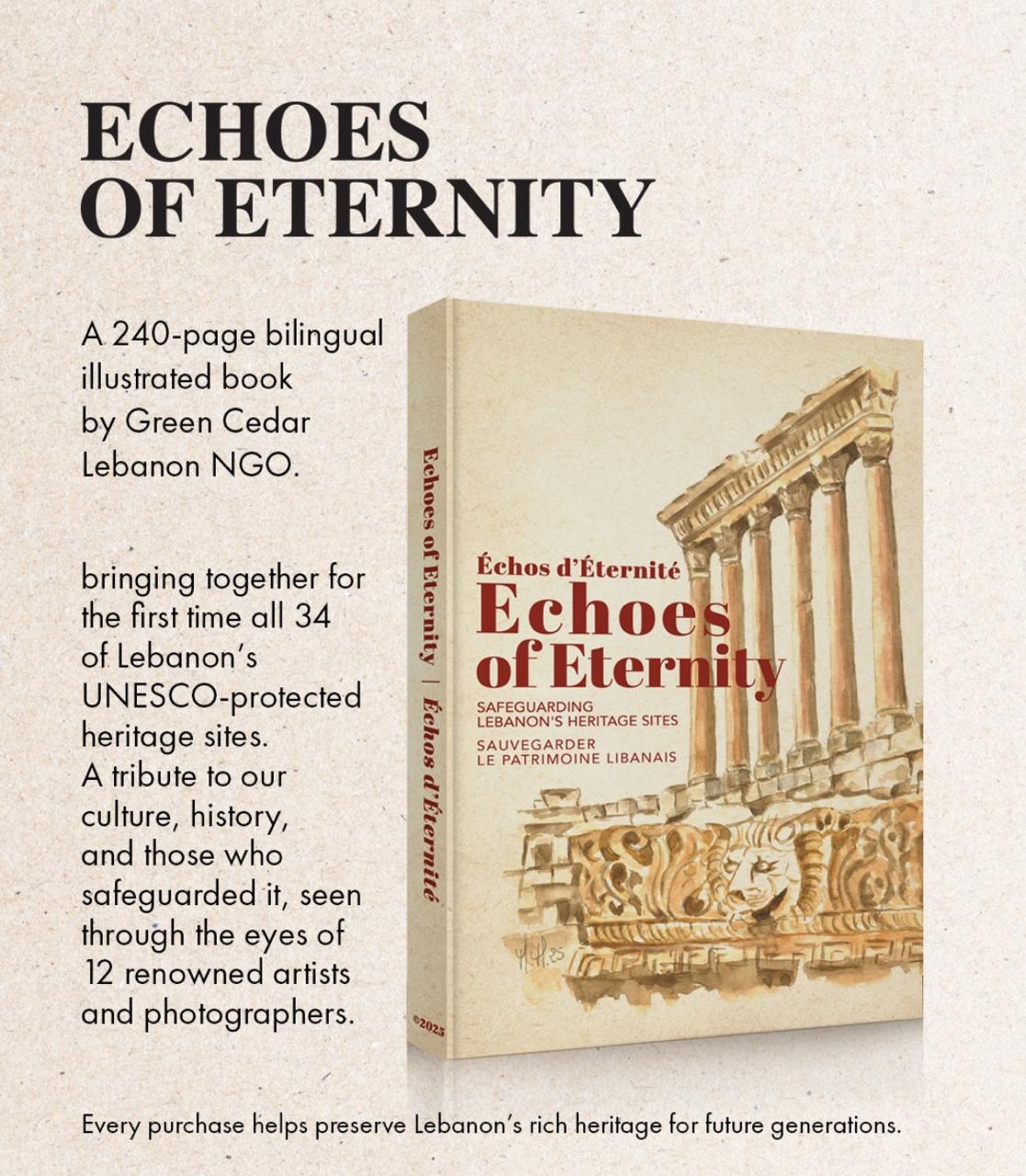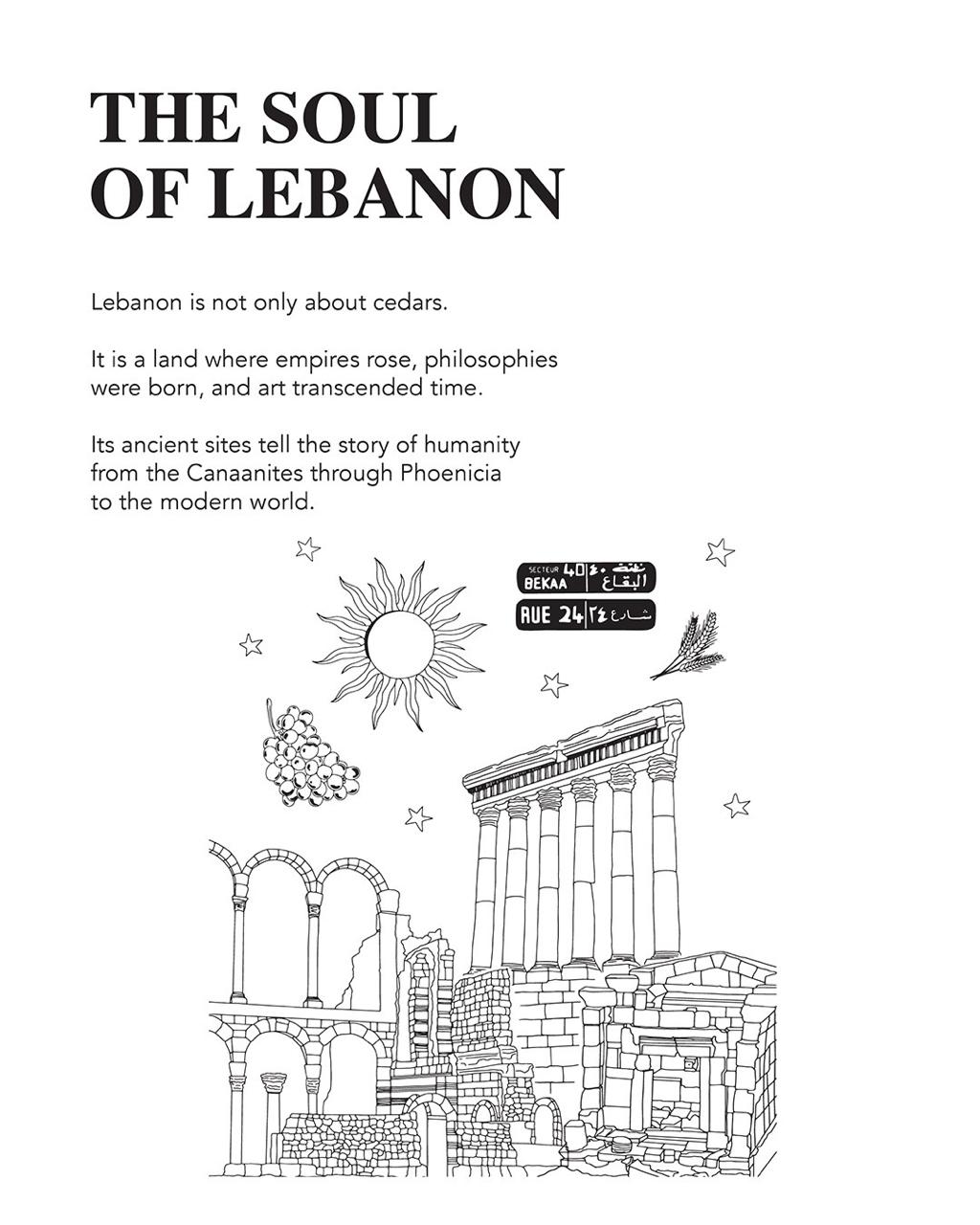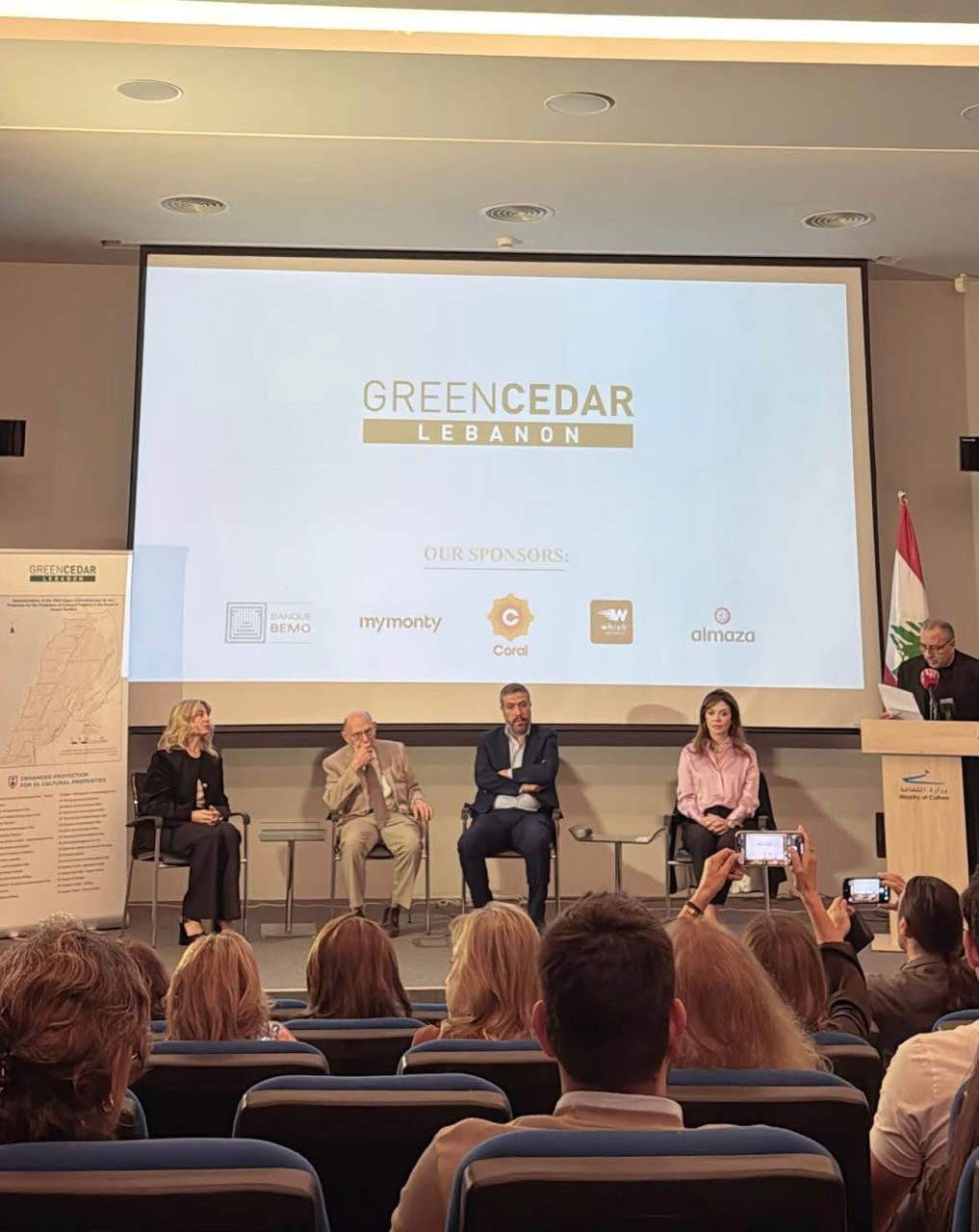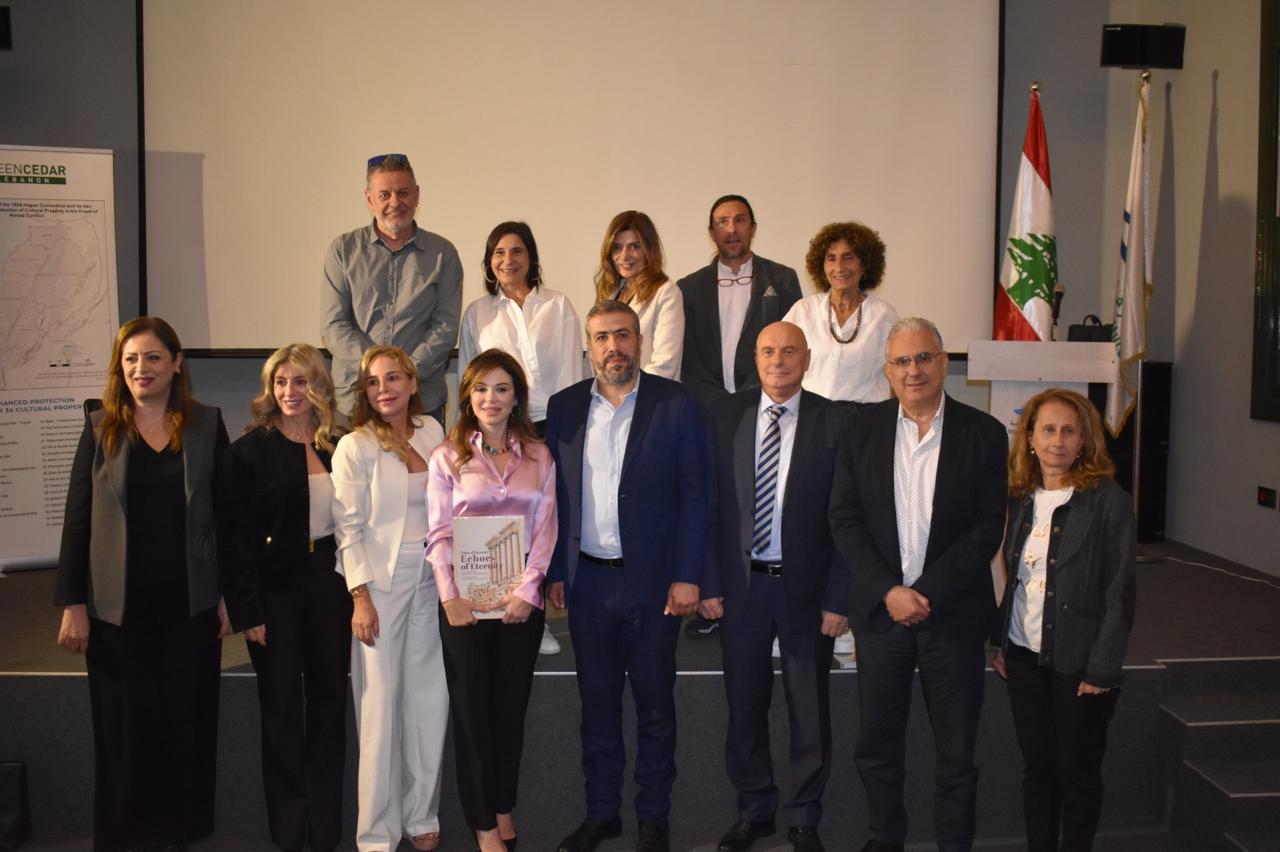Under the patronage of the Ministry of Culture – Directorate General of Antiquities, a press conference was held to launch Echoes of Eternity / Échos d’Éternité, a landmark bilingual publication by Green Cedar Lebanon, led by its president Pascale Chehouri Saad.
The event, held at the National Library in Sanayeh, commemorated a milestone in heritage preservation: the inscription of 34 archaeological and cultural sites across Lebanon under UNESCO’s enhanced protection framework.

The richly illustrated 240-page book—featuring the work of 12 Lebanese artists and photographers—celebrates not only the beauty of these sites but also the urgent efforts made to safeguard them amid mounting regional threats. Translated into both French and English, “Echoes of Eternity” presents 34 archaeological sites in Lebanon and outlines the process for their inclusion under UNESCO’s World Heritage List with enhanced protection.

Attended by Director General of Antiquities Sarkis Khoury, Advisor to the Minister of Culture for Archaeological Affairs Jad Tabet, Télé Liban Chairwoman Elissar Naddaf Geagea, and a distinguished audience of archaeologists, academics, and creatives, the launch reinforced Lebanon’s commitment to cultural preservation even in times of crisis.
The event marked one year since the threat to Lebanon’s archaeological landmarks, from the Castle of Shemaa to Baalbek and others.
After the Lebanese national anthem, Green Cedar Lebanon President Pascale Saad addressed heritage lovers:
“Since 2007, Green Cedar Lebanon has worked tirelessly to preserve the spirit of Lebanon through reforestation, mountain planting, and supporting the arts. We firmly believe that culture and nature are two faces of the same spirit: if we protect one, we save the other.”
She added, “In November 2024, 34 cultural and archaeological sites in Lebanon were placed under UNESCO’s enhanced protection. Echoes of Eternity sheds light on these exceptional sites and honors all those who worked hard to make this historic achievement possible. This book is a journey into the cultural and historical soul of Lebanon. For the first time, these 34 sites are presented through text, photography, and artistic renderings in a sensitive, beautiful, and passionate portrayal of our ancient heritage.”
“Through its pages, we invite readers to rediscover Lebanon—not just as the ‘Land of Cedars’ but as the ‘Cradle of Civilization.’ The land of our ancestors still bears living witness to the history of humanity. From Baalbek to Byblos, from Tyre to Anjar, Lebanon is an open-air museum embodying Mediterranean heritage. Empires rose here, philosophies were born, and art transcended time. Its ancient sites tell the story of humankind—from the Canaanites and Phoenicians to the modern world. In Lebanon, every stone carries the memory of a civilization. Let us be like the cedars: our roots deep in our land and history, and our branches reaching toward the future.”
She concluded, “A heartfelt thanks to Mr. Jad Tabet, Mr. Sarkis Khoury, Ms. Samar Karam, and the entire Directorate General of Antiquities team—thanks to their tireless efforts, we were able to preserve these sites. I also thank archaeologist and historian Marie Lam’a, without whom this book would not have seen the light. I express my deep gratitude to all the artists, photographers, and illustrators who contributed to the book. Through their sensitive perspectives, we are able to see these sites anew and embody them with emotion and beauty.”

Advisor to the Minister of Culture:
Jad Tabet, Advisor to the Minister of Culture for Archaeological Affairs, stated:
“From the earliest weeks of the Israeli aggression in the fall of last year, cities and villages in South Lebanon and the Bekaa Valley were subjected to continuous bombardment. This heavy shelling caused not only widespread human and material devastation but also posed a serious threat to the unique cultural landscape of these areas. Traditional urban centers and rural regions rich in centuries-old architecture, historical layers, and natural landmarks were placed in immediate danger.”
He emphasized:
“As the hostilities escalated and heritage sites were increasingly targeted, it became evident that Lebanon’s cultural identity was facing systematic destruction. This prompted urgent calls to the international community, especially UNESCO, to take swift action to protect Lebanon’s cultural heritage. Campaigns and petitions launched by NGOs, cultural institutions, and extensive media coverage played a vital role in raising global awareness of the imminent threats to Lebanon’s heritage.”
“In parallel,” he continued, “the Lebanese Ministry of Culture—specifically the Directorate General of Antiquities—in close consultation with Lebanon’s Permanent Mission to UNESCO, prepared a comprehensive file on a group of archaeological sites. This was submitted to the Committee for the Protection of Cultural Property in the Event of Armed Conflict under the Second Protocol of the Hague Convention. This collaborative effort reflected a strong national commitment to safeguarding our cultural heritage amid increasing threats. The file preparation involved extensive research, thorough documentation, and legal justification to demonstrate the urgent need for enhanced protection.”
“The committee, composed of twelve member states, required the attendance of ten countries to reach quorum—a difficult feat within the short time available. Nevertheless, we succeeded, and the committee convened on November 18, 2024.”
Tabet explained that the initial focus was on sites in the South and Bekaa, but as military operations expanded to other parts of Lebanon, it became clear that heritage sites nationwide were under threat. The scope was broadened to include 34 major heritage sites across Lebanon—an unprecedented move given that the total number of sites globally under enhanced protection was only 56.
He noted, “Due to the significant efforts to achieve quorum in time, we entered the meeting with considerable concern, especially under pressure from the Israeli side, which downplayed the scale of destruction, claiming the bombardment only targeted military sites. Surprisingly, the ten committee members present unanimously supported our proposal. At a decisive moment, the committee chair suggested an immediate vote to grant enhanced protection to the entire group rather than reviewing each site individually. The proposal was unanimously approved, and the full list of properties was placed under enhanced protection without delay. The committee also approved financial aid for Lebanon from the Cultural Property Protection Fund in Armed Conflict.”
He concluded, “In times of war, heritage occupies a special place. While wars are fought over land, power, or ideology, the destruction of cultural heritage strikes at something deeper—identity, memory, and the spirit of a people. Protecting heritage in war is not merely about saving buildings; it’s about safeguarding the values they represent. These sites carry the stories, achievements, beliefs, and struggles of generations. They anchor communities in their past, sustain them in the present, and help shape a shared vision for the future. Destroying heritage is not just breaking stones—it severs the historical continuity of a society. Protecting heritage in wartime is not a luxury or a secondary issue—it is a moral and human duty. Preserving heritage is preserving humanity itself: its diversity, creativity, and enduring ability to remember, learn, and grow amid devastation. It is a fundamental expression of resilience and resistance.”

Director of Antiquities:
Director General of Antiquities Sarkis Khoury then spoke of the challenges and wars Lebanon has faced, which, as he stated, “have posed threats to archaeological sites—from the 1975 war, the 1982 invasion, the 1996 and 2006 conflicts, to the Beirut port explosion, whose restoration efforts are still ongoing. The latest crisis in the South forced the Directorate General of Antiquities to act to protect these sites, including the National Museum.”
He added, “Our priority has always been to protect Lebanese heritage, building on cumulative efforts dating back to the Directorate’s establishment. A key milestone came in 2019 when the President of the Republic and the Lebanese Parliament approved the Second Protocol of the Hague Convention. Without this signature, we wouldn’t have achieved what we did.”
“When the war began,” he said, “I must salute the unsung heroes who united through every hardship. Despite Lebanon’s dire state—no electricity, a collapsing infrastructure—we managed within a month to compile a list of 34 sites for submission under UNESCO enhanced protection, with help from Khatib & Alami. We prepared to travel to Paris via Beirut Airport, which was under threat at the time, while bombings were ongoing in Dahieh and Tayouneh.”
He concluded, “None of this would have been possible without the cooperation of our friends in the Lebanese Army, who facilitated coordination with the Ministry of Defense to exclude these sites from military use. We also owe gratitude to our ambassador Mustafa Adib, who led crucial diplomatic efforts. This proves that institutional cooperation bears fruit when there is genuine intent. Finally, I thank the Green Cedar Association for this initiative that led to a successful and meaningful partnership.”
The 34 Sites Under Enhanced Protection:
Finally, contributions were made on the importance of heritage and its reflection of Lebanon’s history and civilization. Elissar Naddaf, Chair of Télé Liban, emphasized, “One of the station’s top priorities is to focus on culture and raise awareness about the importance of protecting our heritage.”